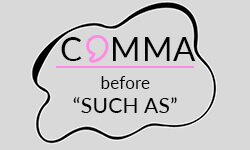
Many students struggle with using commas correctly in academic writing, which can often lead to mistakes and uncertainty. This is usually because they don’t fully understand the rules and exceptions that apply to their use. This article aims to help clarify the appropriate usage of commas before the prepositional phrase “such as”, by providing examples and explaining any exceptions to the rules.
When to place a comma before “such as”
In general, there is only one rule when a comma must be placed before “such as”. This is the case, when “such as” is part of a non-restrictive clause. A non-restrictive clause is additional information that could be omitted without affecting the main meaning of the sentence.
Comma
Non-restrictive clause
No comma
Restrictive clause
Different Style Guides may have varying rules when it comes to using commas. In addition, certain complex sentences may have exceptions to the standard comma placement rules. It’s important to keep in mind whether a comma is necessary to ensure that your sentence is easy to read and understand.
Comma before “such as”
When the phrase “such as” introduces non-restrictive clauses, a comma is necessary before “such as”.
Non-restrictive clauses
When a non-restrictive clause is introduced by “such as”, a comma should be used to separate the non-essential information from the main sentence. The comma signals to the reader that the information following “such as” is not crucial to the sentence’s core meaning.
No comma before “such as”
Generally, no comma is placed before “such as” if the phrase introduces a restrictive clause.
Restrictive clause
Occasionally, “such as” is utilized to introduce a restrictive clause that is imperative in conveying the intended message and identifying the subject matter. Omitting it would result in ambiguity or a less precise statement. It is crucial to keep in mind that restrictive clauses should not be isolated by commas.
Test yourself!
Practice sheet
Try improving your understanding of when to use commas before “such as” by placing them in the appropriate positions in the 10 provided sentences. Then, refer to the second tab named “Answers” to check if your comprehension is correct.
- She has travelled to countries such as France Italy and Japan.
- Foods such as ice cream and burgers aren’t good for your health.
- The team focuses on key areas such as strategy marketing and innovation.
- The garden boasts a variety of plants such as roses lilies and daisies.
- The store offers products such as electronics clothing and accessories.
- We study subjects such as mathematics science and history.
- The event includes activities such as games music and dancing.
- The restaurant serves dishes from cuisines such as Indian Thai and Mexican.
- This year we’d like to visit a country such as Italy or Albania.
- My favourite hobbies include activities such as hiking biking and gardening.
- She has travelled to countries, such as France, Italy, and Japan. (Comma)
- Foods such as ice cream and burgers aren’t good for your health. (No comma)
- The team focuses on key areas such as strategy, marketing, and innovation. (No comma)
- The garden boasts a variety of plants such as roses, lilies, and daisies. (No comma)
- The store offers products such as electronics, clothing, and accessories. (No comma)
- We study subjects such as mathematics, science, and history. (No comma)
- The event includes activities, such as games, music, and dancing. (Comma)
- The restaurant serves dishes from cuisines such as Indian, Thai, and Mexican. (No comma)
- This year we’d like to visit a country such as Italy or Albania. (No comma)
- My favourite hobbies include activities, such as hiking, biking, and gardening. (Comma)
numerous advantages for Canadian students:
- ✓ 3D live preview of your configuration
- ✓ Free express delivery for every order
- ✓ High-quality bindings with individual embossing

FAQs
You only use a comma before “such as” if the phrase introduces a non-restrictive clause, meaning the information is irrelevant to the core meaning of the sentence.
Ask yourself whether the meaning of the sentence changes when omitting the part after “such as”. If the answer is no, then you put a comma before “such as”. If the information is essential to the meaning, you don’t put a comma before “such as”.
Yes, you use a comma before “such as” when the information that follows is not essential to the sentence’s meaning (non-restrictive clause).
- She enjoys various hobbies, such as painting and playing the piano. (Not essential information)
- The subjects such as math and science are required for this program. (Essential information)
A semicolon is not commonly used before “such as”. Semicolons are usually employed to separate two independent clauses (complete sentences) that are closely related. “Such as” introduces examples rather than complete sentences, so a semicolon is not the appropriate punctuation in this context.
When “such as” is used to introduce a list of examples, a comma is typically placed after “such as” to separate the introductory phrase from the list. This helps to signal that the examples are about to follow. However, the comma is not placed directly after “such as”.
- The menu includes a variety of dishes, such as pasta, pizza, burgers, and salads.
